Study of the Ultraviolet Effect and Thermal Analysis on Polypropylene Nonwoven Geotextile
Abstract
:1. Introduction
2. Materials and Methods
2.1. Geotextile and Accelerated Weathering Tests
2.2. Mechanical Properties
2.3. Scanning Electron Microscopy
2.4. Thermal Analysis Methodology
3. Results and Discussion
3.1. Thermoanalytical Analyses
3.1.1. TG/DTG and DTA Analyses
3.1.2. Kinetic Analysis
3.1.3. DSC and TMA Analyses
3.2. Scanning Electronc Microscopy
3.3. Tensile Properties
4. Conclusions
Author Contributions
Funding
Data Availability Statement
Acknowledgments
Conflicts of Interest
References
- Moo-Young, H.K.; Gaffney, D.A.; Mo, X. Testing procedures to assess the viability of dewatering with geotextile tubes. Geotext. Geomembr. 2002, 20, 289–303. [Google Scholar] [CrossRef]
- Shin, E.C.; Oh, Y.I. Coastal erosion prevention by geotextile tube technology. Geotext. Geomembr. 2007, 25, 264–277. [Google Scholar] [CrossRef]
- Kim, H.J.; Dinoy, P.R.; Kim, H.S. Tension force analysis of geotextile tubes by half cross-section test. Geotext. Geomembr. 2020, 48, 243–256. [Google Scholar] [CrossRef]
- Koerner, G.R.; Hsuan, G.Y.; Koerner, R.M. Photo-Initiated Degradation of Geotextiles. J. Geotech. Geoenviron. Eng. 1998, 124, 1159–1166. [Google Scholar] [CrossRef]
- Carneiro, J.R.; Almeida, P.J.; Lopes, M.L. Evaluation of the Resistance of a Polypropylene Geotextile against Ultraviolet Radiation. Microsc. Microanal. 2019, 25, 196–202. [Google Scholar] [CrossRef] [PubMed]
- Carneiro, J.R.; Almeida, P.J.; Lopes, M.L. Effect of antioxidants and UV stabilisers in the resistance of polypropylene geotextiles against oxidation: The case of Chimassorb 944. In Proceedings of the 3rd African Regional Conference on Geosynthetics, Marrakech, Morocco, 8–11 October 2017; pp. 301–310. [Google Scholar]
- Richaud, E.; Farcas, F.; Divet, L.; Paul Benneton, J. Accelerated ageing of polypropylene geotextiles, the effect of temperature, oxygen pressure and aqueous media on fibers—Methodological aspects. Geotext. Geomembr. 2008, 26, 71–81. [Google Scholar] [CrossRef]
- Lopes, M.P.; Lopes, M.P. A Durabilidade dos Geossintéticos, 1st ed.; FEUP Edições: Porto, Portugal, 2010. (In Portuguese) [Google Scholar]
- Faure, Y.H.; Farkouh, B.; Delmas, P.; Nancey, A. Analysis of geotextile filter behaviour after 21 years in Valcros dam. Geotext. Geomembr. 1999, 17, 353–370. [Google Scholar] [CrossRef]
- Müller, W.W.; Jakob, I.; Li, C.S.; Tatzky-Gerth, R. Durability of polyolefin geosynthetic drains. Geosynth. Int. 2009, 16, 28–42. [Google Scholar] [CrossRef]
- Khoironi, A.; Hadiyanto, H.; Anggoro, S.; Sudarno, S. Evaluation of polypropylene plastic degradation and microplastic identification in sediments at Tambak Lorok coastal area, Semarang, Indonesia. Mar. Pollut. Bull. 2020, 151, 110868. [Google Scholar] [CrossRef]
- Guimarães, M.G.A.; Vidal, D.M.; Urashima, D.C.; Castro, C.A.C. Degradation of polypropylene woven geotextile: Tensile creep and weathering. Geosynth. Int. 2017, 24, 213–223. [Google Scholar] [CrossRef]
- Bertin, D.; Leblanc, M.; Marque, S.R.A.; Siri, D. Polypropylene degradation: Theoretical and experimental investigations. Polym. Degrad. Stab. 2010, 95, 782–791. [Google Scholar] [CrossRef]
- Gupta, A.P.; Saroop, U.K.; Gupta, V. Studies on the photo-oxidation of PP and PP/mLLDPE blend systems: Thermal, physicochemical, and mechanical behavior. J. Appl. Polym. Sci. 2007, 106, 917–925. [Google Scholar] [CrossRef]
- Carneiro, J.R.; Almeida, P.J.; Lopes, M.L. Some synergisms in the laboratory degradation of a polypropylene geotextile. Constr. Build. Mater. 2014, 73, 586–591. [Google Scholar] [CrossRef]
- Horrocks, A.; Mwila, J.; Miraftab, M.; Liu, M.; Chohan, S. The influence of carbon black on properties of orientated polypropylene 2 Thermal and photodegradation. Polym. Degrad. Stab. 1999, 65, 25–36. [Google Scholar] [CrossRef]
- ASTM (American Society for Testing and Materials). ASTM D 5261-92 Standard Test Method for Measuring Mass per Unit Area of Geotextiles; ASTM: West Conshohocken, PA, USA, 2003. [Google Scholar] [CrossRef]
- ASTM (American Society for Testing and Materials). ASTM D 5199-01 Standard Test Method for Measuring the Nominal Thickness of Geosynthetics; ASTM: West Conshohocken, PA, USA, 2006. [Google Scholar] [CrossRef]
- ASTM (American Society for Testing and Materials). ASTM D 4833(M)-07 Standard Test Method for Index Puncture Resistance of Geomembranes and Related Products; ASTM: West Conshohocken, PA, USA, 2013. [Google Scholar] [CrossRef]
- ASTM (American Society for Testing and Materials). ASTM D 5035-06 Standard Test Method for Breaking Strength and Elongation of Textile Fabrics (Strip Method); ASTM: West Conshohocken, PA, USA, 2008. [Google Scholar] [CrossRef]
- Valentin, C.A.; Silva, J.L.; Kobelnik, M.; Ribeiro, C.A. Thermoanalytical and dynamic mechanical analysis of commercial geomembranes used for fluid retention of leaching in sanitary landfills. J. Therm. Anal. Calorim. 2019, 136, 471–481. [Google Scholar] [CrossRef] [Green Version]
- Souza, J.L.; Kobelnik, M.; Ribeiro, C.A.; Capela, J.M.V.; Crespi, M.S. Kinetic study of crystallization of PHB in presence of hydroxy acids. J. Therm. Anal. Calorim. 2009, 97, 525–528. [Google Scholar] [CrossRef]
- Ribeiro, R.P.; Kobelnik, M.; Parizotto, J.C.V. Mineralogical and thermal characterization of soft rock from Campinas, Brazil. J. Therm. Anal. Calorim. 2019, 136, 483–492. [Google Scholar] [CrossRef]
- Rawal, A.; Shah, T.; Anand, S. Geotextiles: Production, properties and performance. Text. Prog. 2010, 42, 181–226. [Google Scholar] [CrossRef]
- Flynn, J.H.; Wall, L.A. A quick, direct method for the determination of activation energy from thermogravimetric data. Polym. Lett. 1966, 14, 323–328. [Google Scholar] [CrossRef]
- Ozawa, T. A New Method of Analyzing Thermogravimetric Data. Bull. Chem. Soc. Jpn. 1965, 38, 1881–1886. [Google Scholar] [CrossRef] [Green Version]
- Ozawa, T. Kinetic analysis of derivative curves in thermal analysis. J. Therm. Anal. 1970, 2, 301–324. [Google Scholar] [CrossRef]
- Ozawa, T. Kinetics of non-isothermal crystallization. Polymer 1971, 12, 150–158. [Google Scholar] [CrossRef]
- Collar, E.P.; Marco, C.; Laguna, O.; Areso, S.; García-Martínez, J.M. On the changes in glass transition temperatures of atactic polypropylenes induced by grafting of polar groups. J. Therm. Anal. Calorim. 1999, 58, 541–550. [Google Scholar] [CrossRef]
- Carneiro, J.R.; Lopes, M.L. Natural weathering of polypropylene geotextiles treated with different chemical stabilisers. Geosynth. Int. 2017, 24, 544–553. [Google Scholar] [CrossRef]
- Koerner, R.M. Designing with Geosynthetics, 5th ed.; Pearson Prentice Hall: Upper Saddle River, NJ, USA, 2005. [Google Scholar]
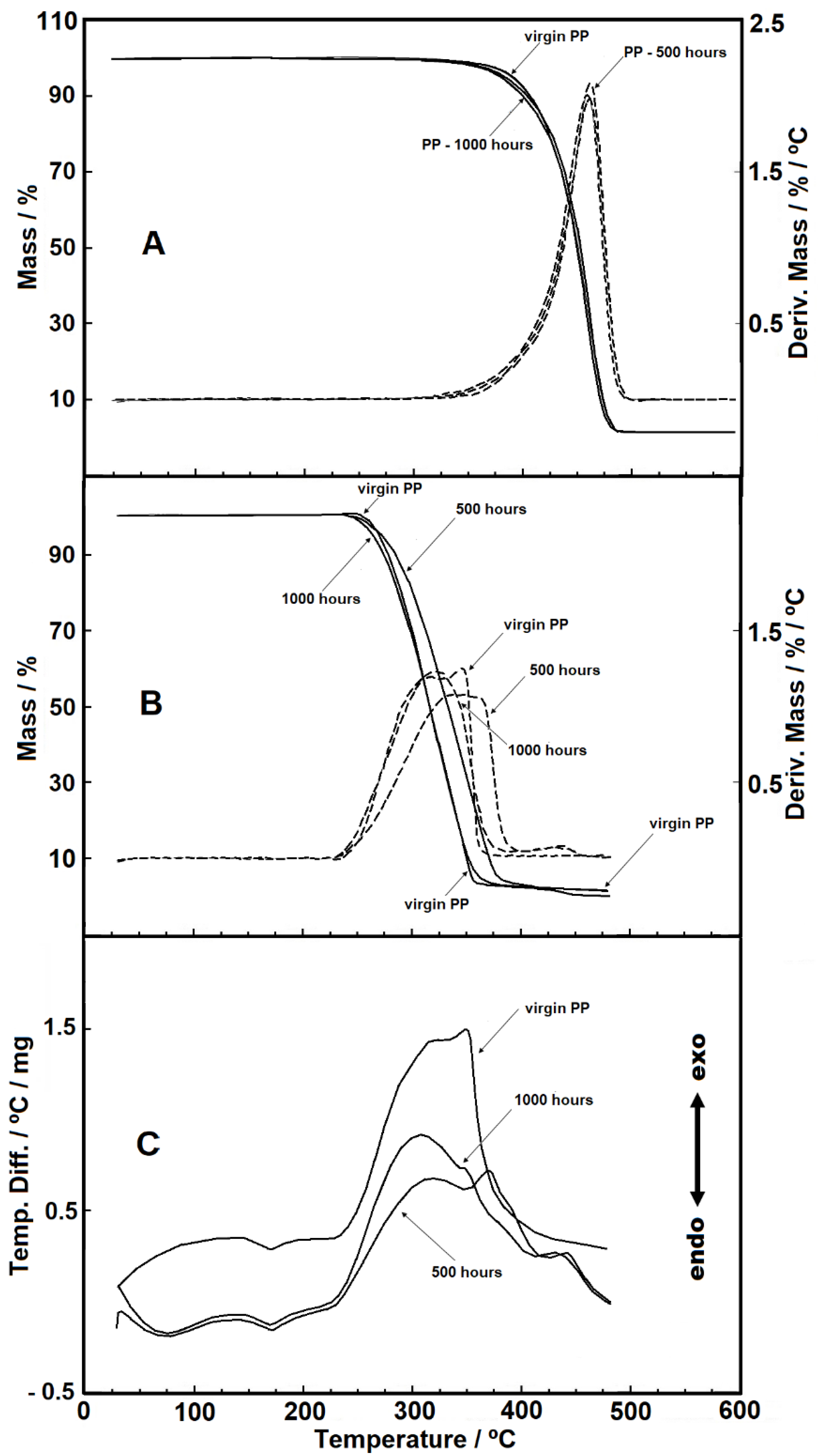
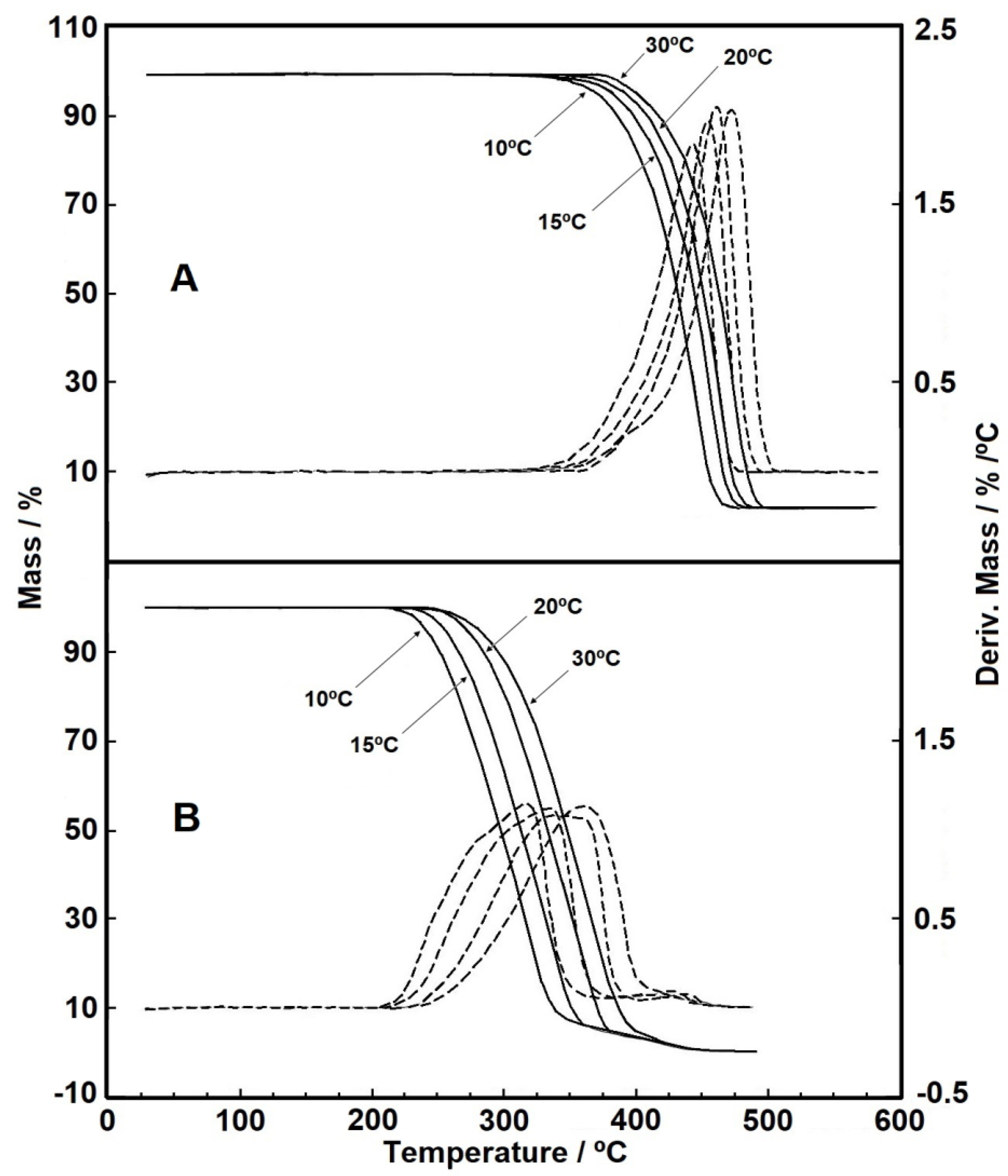
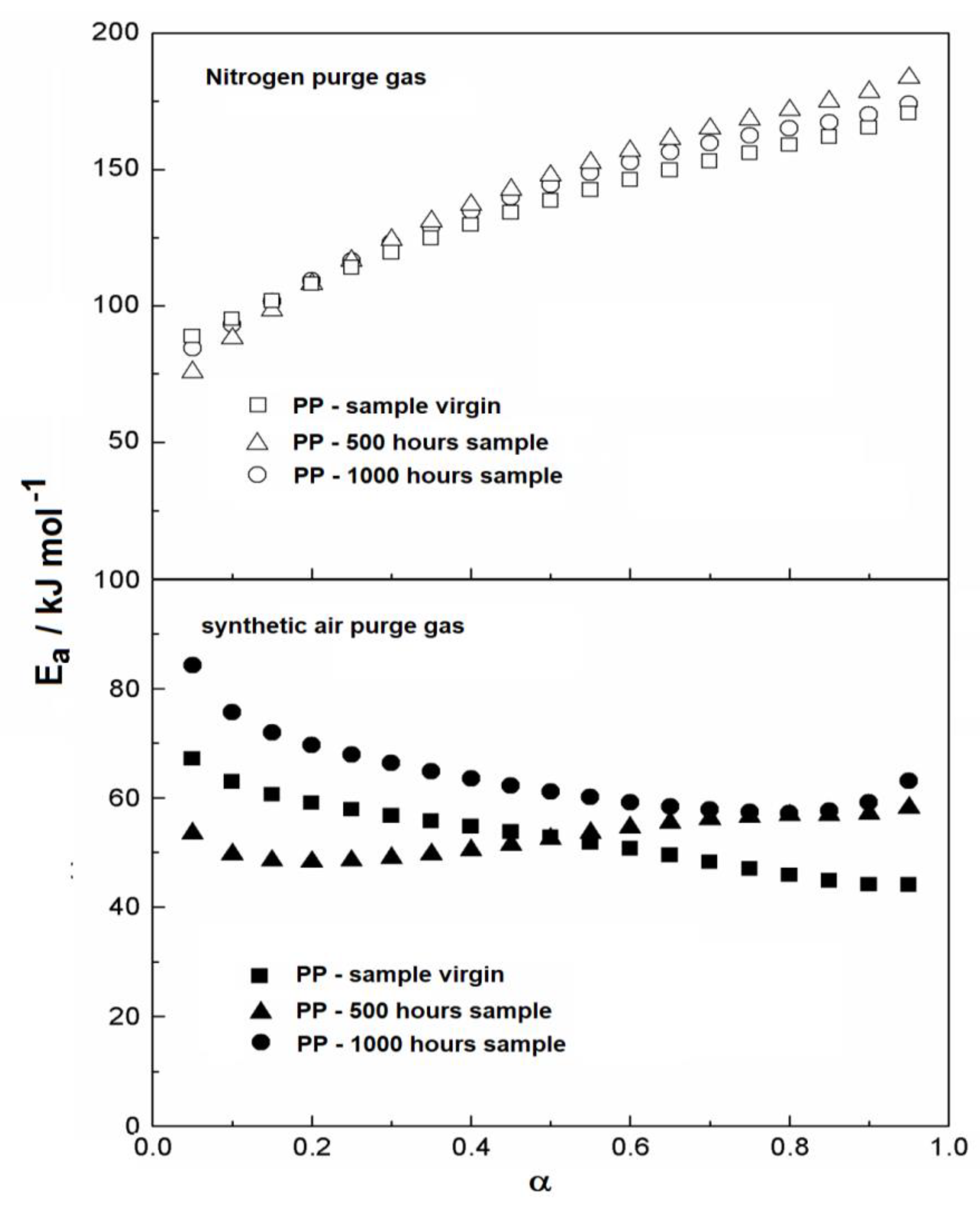

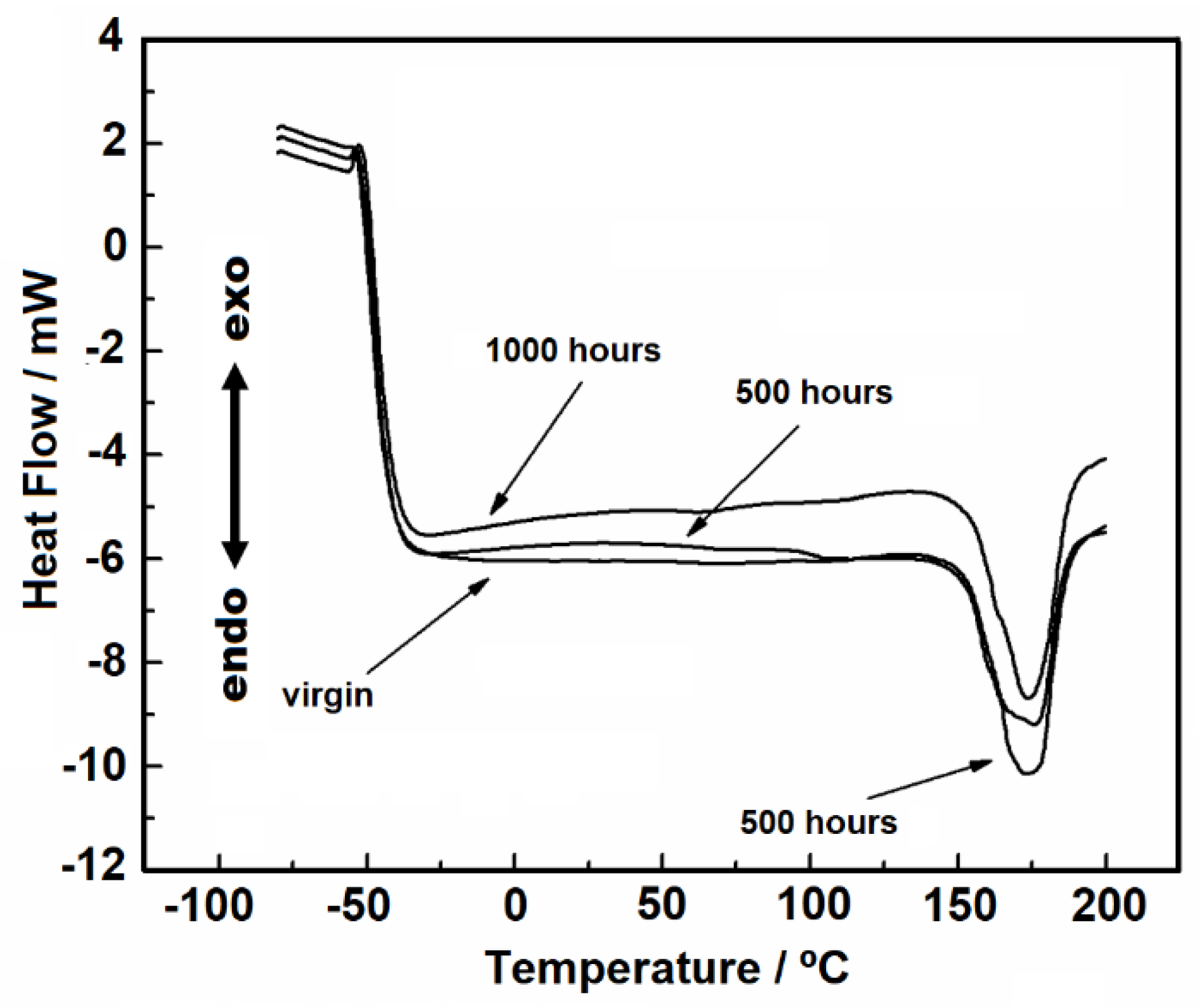


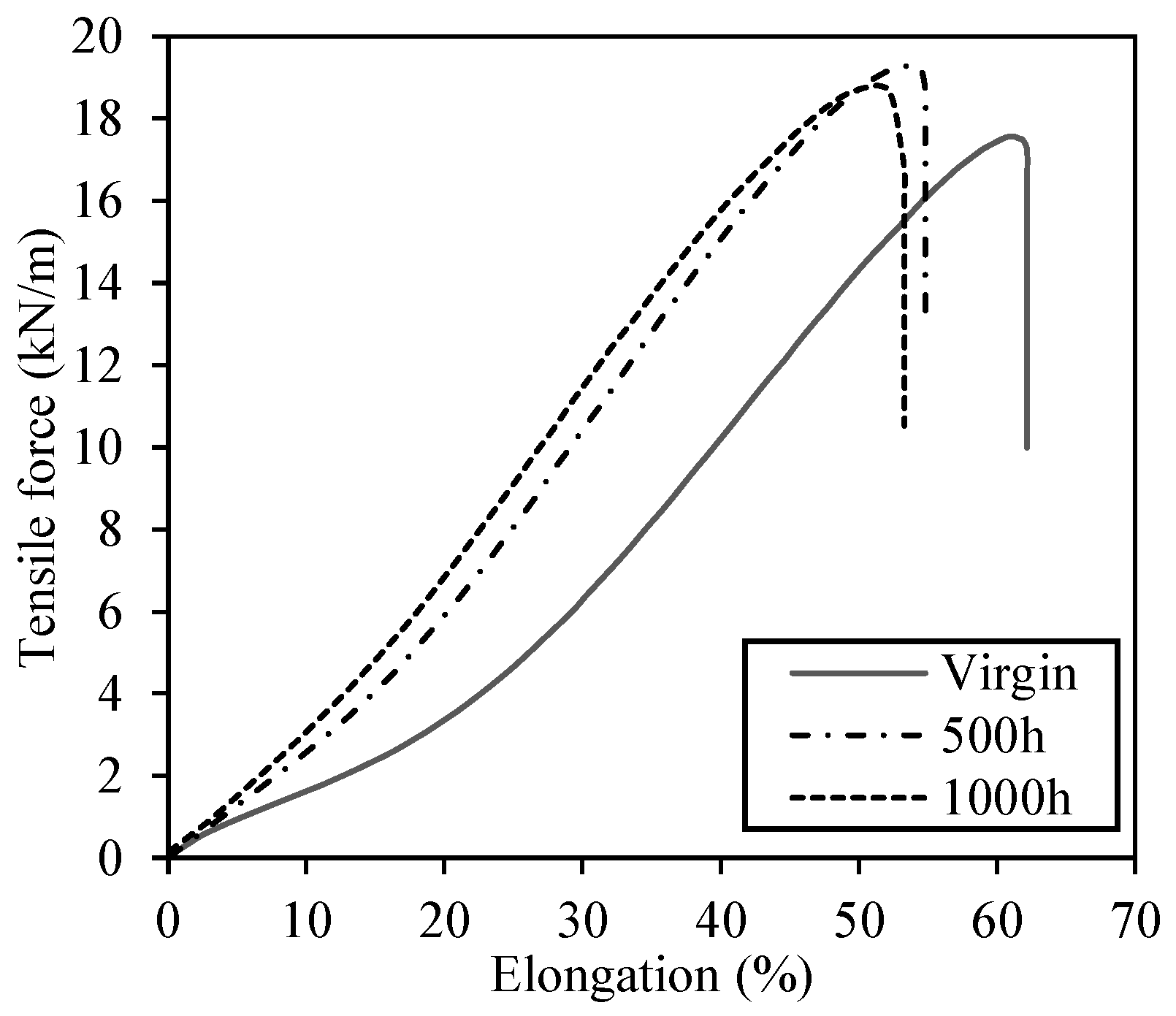
| MPA (g m−2) | Thickness (mm) | Puncture Resistance (N) | Tensile Resist./(kN m−1) | Tensile Elong./(%) |
|---|---|---|---|---|
| 412.3 | 3.58 | 729.54 | 17.91 | 62.92 |
| (±5.95) | (±0.07) | (±107.21) | (±0.99) | (±2.35) |
| Compound/Purge Gas | Stage | ∆T (°C) | Mass Loss (%) |
|---|---|---|---|
| Virgin PP (synthetic air) | 1 | 235–369 | 98.6 |
| residue | --- | 1.4 | |
| 500 h (synthetic air) | 1 | 228–396 | 97.25 |
| 2 | 396–478 | 2.75 | |
| residue | --- | 0 | |
| 1000 h (synthetic air) | 1 | 228–384 | 97.45 |
| 2 | 384–478 | 2.55 | |
| residue | --- | 0 | |
| Virgin PP (nitrogen) | 1 | 350–397 | 97.24 |
| residue | --- | 2.76 | |
| 500 h (nitrogen) | 1 | 331–498 | 97.52 |
| residue | --- | 2.48 | |
| 1000 h (nitrogen) | 1 | 315–498 | 99.14 |
| residue | --- | 0.86 |
| Purge Gas and Sample | Temperature Ranges for Kinetic Evaluation (DTG Curves) | *Ea/kJ mol−1 | *r |
|---|---|---|---|
| Synthetic air Virgin PP | (10 °C) 224–316 °C | 53.20 (±0.13) | 0.97959 |
| (15 °C) 231–338 °C | |||
| (20 °C) 237–366 °C | |||
| (30 °C) 252–375 °C | |||
| Synthetic air PP 500 h | (10 °C) 208–361 °C | 53.10 (±0.08) | 0.97659 |
| (15 °C) 214–378 °C | |||
| (20 °C) 230–398 °C | |||
| (30 °C) 238–409 °C | |||
| Synthetic air PP 1000 h | (10 °C) 222–348 °C | 64.08 (±0.11) | 0.99965 |
| (15 °C) 230–367 °C | |||
| (20 °C) 231–379 °C | |||
| (30 °C) 239–396 °C | |||
| Nitrogen Virgin PP | (10 °C) 342–477 °C | 134.00 (±0.18) | 0.99591 |
| (15 °C) 360–491 °C | |||
| (20 °C) 380–496 °C | |||
| (30 °C) 392–505 °C | |||
| Nitrogen PP 500 h | (10 °C) 334–482 °C | 141.11 (±0.22) | 0.97306 |
| (15 °C) 341–490 °C | |||
| (20 °C) 365–495 °C | |||
| (30 °C) 392–505 °C | |||
| Nitrogen PP 1000 h | (10 °C) 323–478 °C | 140.70 (±0.19) | 0.99976 |
| (15 °C) 335–492 °C | |||
| (20 °C) 349–495 °C | |||
| (30 °C) 372–509 °C |
| Aged Sample | Tensile Resist./(kN m−1) | Tensile Elong. at Break/(%) |
|---|---|---|
| PP 500 h | 19.63 | 54.77 |
| (±2.77) | (±2.14) | |
| PP 1000 h | 19.27 | 52.69 |
| (±1.98) | (±2.93) |
Publisher’s Note: MDPI stays neutral with regard to jurisdictional claims in published maps and institutional affiliations. |
© 2021 by the authors. Licensee MDPI, Basel, Switzerland. This article is an open access article distributed under the terms and conditions of the Creative Commons Attribution (CC BY) license (http://creativecommons.org/licenses/by/4.0/).
Share and Cite
Valentin, C.A.; Kobelnik, M.; Franco, Y.B.; Lavoie, F.L.; Silva, J.L.d.; Luz, M.P.d. Study of the Ultraviolet Effect and Thermal Analysis on Polypropylene Nonwoven Geotextile. Materials 2021, 14, 1080. https://doi.org/10.3390/ma14051080
Valentin CA, Kobelnik M, Franco YB, Lavoie FL, Silva JLd, Luz MPd. Study of the Ultraviolet Effect and Thermal Analysis on Polypropylene Nonwoven Geotextile. Materials. 2021; 14(5):1080. https://doi.org/10.3390/ma14051080
Chicago/Turabian StyleValentin, Clever Aparecido, Marcelo Kobelnik, Yara Barbosa Franco, Fernando Luiz Lavoie, Jefferson Lins da Silva, and Marta Pereira da Luz. 2021. "Study of the Ultraviolet Effect and Thermal Analysis on Polypropylene Nonwoven Geotextile" Materials 14, no. 5: 1080. https://doi.org/10.3390/ma14051080








